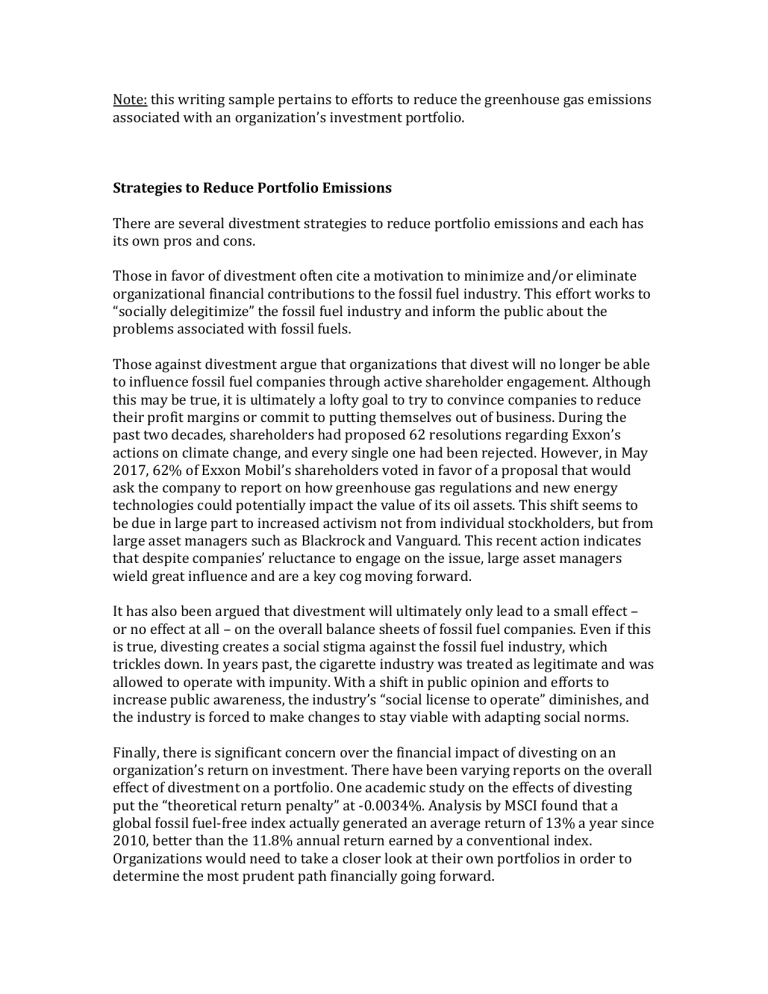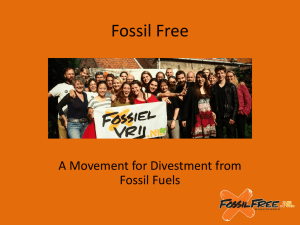
Note: this writing sample pertains to efforts to reduce the greenhouse gas emissions associated with an organization’s investment portfolio. Strategies to Reduce Portfolio Emissions There are several divestment strategies to reduce portfolio emissions and each has its own pros and cons. Those in favor of divestment often cite a motivation to minimize and/or eliminate organizational financial contributions to the fossil fuel industry. This effort works to “socially delegitimize” the fossil fuel industry and inform the public about the problems associated with fossil fuels. Those against divestment argue that organizations that divest will no longer be able to influence fossil fuel companies through active shareholder engagement. Although this may be true, it is ultimately a lofty goal to try to convince companies to reduce their profit margins or commit to putting themselves out of business. During the past two decades, shareholders had proposed 62 resolutions regarding Exxon’s actions on climate change, and every single one had been rejected. However, in May 2017, 62% of Exxon Mobil’s shareholders voted in favor of a proposal that would ask the company to report on how greenhouse gas regulations and new energy technologies could potentially impact the value of its oil assets. This shift seems to be due in large part to increased activism not from individual stockholders, but from large asset managers such as Blackrock and Vanguard. This recent action indicates that despite companies’ reluctance to engage on the issue, large asset managers wield great influence and are a key cog moving forward. It has also been argued that divestment will ultimately only lead to a small effect – or no effect at all – on the overall balance sheets of fossil fuel companies. Even if this is true, divesting creates a social stigma against the fossil fuel industry, which trickles down. In years past, the cigarette industry was treated as legitimate and was allowed to operate with impunity. With a shift in public opinion and efforts to increase public awareness, the industry’s “social license to operate” diminishes, and the industry is forced to make changes to stay viable with adapting social norms. Finally, there is significant concern over the financial impact of divesting on an organization’s return on investment. There have been varying reports on the overall effect of divestment on a portfolio. One academic study on the effects of divesting put the “theoretical return penalty” at -0.0034%. Analysis by MSCI found that a global fossil fuel-free index actually generated an average return of 13% a year since 2010, better than the 11.8% annual return earned by a conventional index. Organizations would need to take a closer look at their own portfolios in order to determine the most prudent path financially going forward. Possible Divestment Strategies There are a variety of ways through which organizations have attempted to divest from fossil fuels. These methods range from keeping some of the current shares in fossil fuel companies to getting rid of all the shares completely. A non-exhaustive list includes: 1. Engaging fossil fuel companies via shareholder meetings: In theory, shareholder activism may be able to influence the direction that companies take. Shareholders are able to participate in shareholder meetings and voice their concerns to representatives of the company. This activity may also involve cooperation with large asset managers. 2. Freezing any new investment in fossil fuel companies: This allows a period of time for organizations to study the effects of their portfolio investments, both environmentally and financially. After gathering results, organizations can develop a strategy moving forward. 3. Purchasing additional shares in clean energy-related equities: This would act as a potential offset for the fossil fuel equities that an organization is unable to fully divest from. Although the portfolio would still contain fossil fuel-related equities, the organization would also be supporting clean energy efforts. 4. Creating an alternative endowment: Some universities have begun collecting donations from alumni who only want to donate to an institution that will not invest in fossil fuels. This endowment would only be available should the organization go through the divestment process. A coalition consisting of alumni from more than a dozen schools, including MIT, Stanford, Dartmouth and Georgetown, have signed on to take part in this. 5. Divesting from select fossil fuel companies: Rather than divesting from all fossil fuel funds, organizations make an effort to target the worst offenders. For example, companies that are exclusively coal-based, have no low-emissions programs, or are within the top X number of fossil fuel companies by size. This effort acknowledges that it may be difficult to fully divest from fossil fuels but can serve as a starting point. 6. Switching to completely fossil fuel free investment portfolios: This is the largest, most impactful step to take and involves fully divesting from all fossil fuelrelated equities. There are portfolios available that are fully “green” and contain no fossil fuel-related investments.



